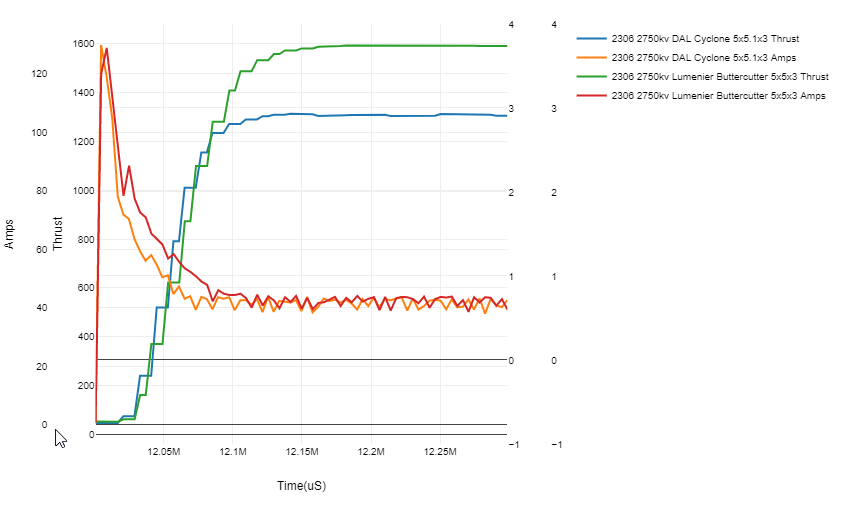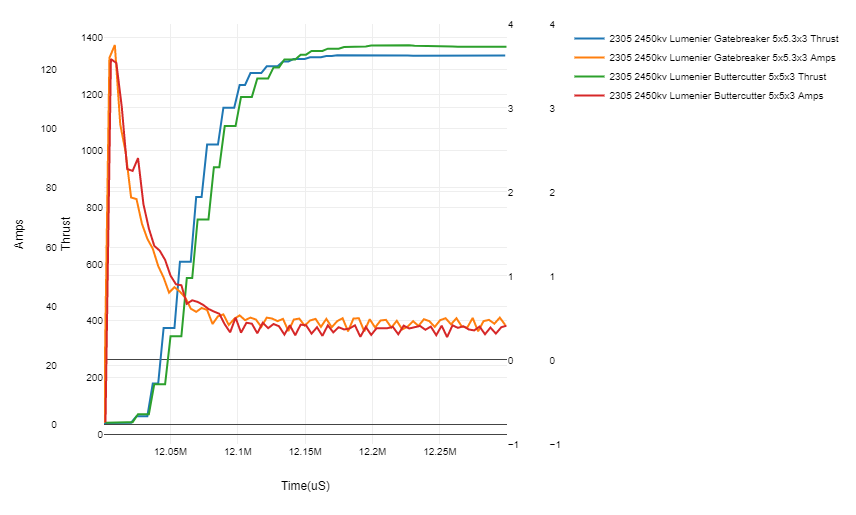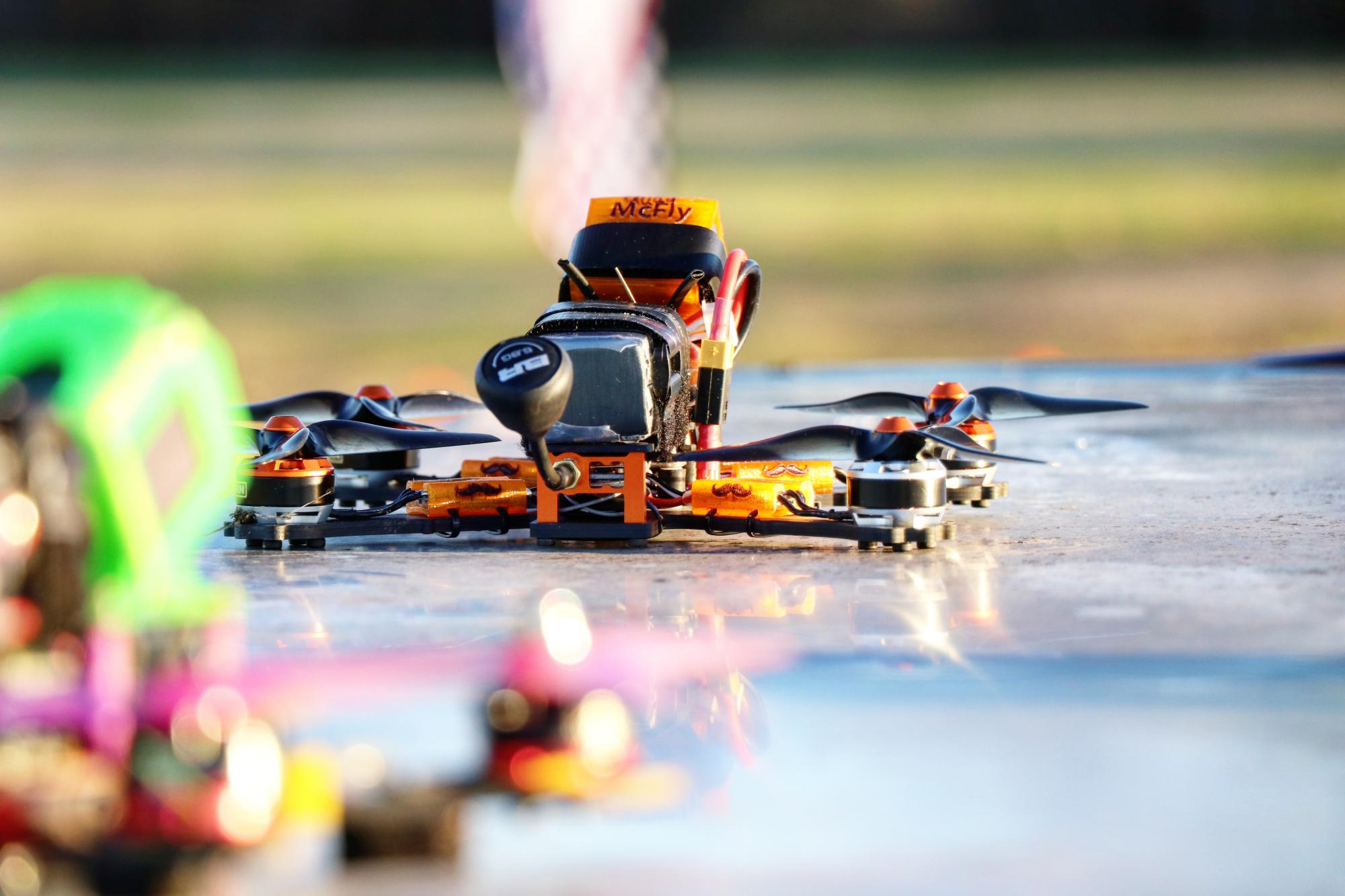Note About New Props

I wanted to make a few notes about some of the new props I've gotten in recently and been adding (or not adding) to the test sequences. There's some interesting information to be garnered here.
Cyclone 5051
If you check the results for the MAD 2306 2750kv motor you can see test results for the DAL Cyclone 5051 prop. The results on this prop are essentially what I expected, but it is worth exploring what is shown here. The current draw is quite high on these, essentially matching the Lumenier Buttercutter 5x5x3. What is interesting, and a bit confusing for those unfamiliar with the testing, is that the thrust is so dramatically lower pretty much across the whole throttle range even though the RPMs are essentially identical to the Buttercutter.
What happens under heavy static load with thin profile high advance ratio props (APC speed props have a similar issue, as well as some of the other thicker props like the RaceKraft 5051, Emax Avan, etc) is that the air begins to stall in front of the prop, basically building up a standing pressure wave that forces the air to split over the prop and loose downward thrust. On the stand you can hear it happening very clearly. Another thing that happens with this prop in particular is the relatively flexible blades end up oscilating and fluttering. On the stand this is very clearly audible, though it would be really fascinating to see in high speed footage. So the question is, what useful information can we learn from the results given these constraints?
The primary thing we can learn here is the relative transition speed of the prop, which combined with the current draw tells us somethign about functional torque loading. 
You can see in the data explorer that the prop reaches thrust equilibrium quite quickly, faster by several milliseconds than the Buttercutter and the Cyclone 5046 for instance. The loss of thrust under static load, and the flexing tells us something important about handling in the air as well. It essentially informs us that in hard corners where the angle of attack(AOA) meets or exceeds static load we will see similar results, and that high torque, high Kv motors are likely to deform the props in those situations, resulting in a lack of grip in the corners, and other high AOA situations. A byproduct of the cavitation in high AOA is also typically slightly reduced prop wash, interestingly enough, though it is hard to say if that will hold true here with all the variables involved.
The high current draw is also likely to be reflected in flight, though it is likely being accentuated by the vibrations and deformation of the prop, so unloading should be quite significant once the AOA lowers sufficiently. That combined with the high pitch, thin profile, and relatively low torque load means this prop is probably ideal for smaller lighter weight, lower torque and upper mid to high kV motors (2500-2600kv) This will keep the RPMs, speed, and the unloading high. The prop should be very snappy, with good speed in forward flight, but a bit loose in hard turns and power loops.
Because the results are not necessarily intuitive for most users, I won't be adding any of these types of props as permanent parts of the test sequence, but I try to run them all at least once to see some of the important data. If you look back through the results over time you might find a few hidden away.
HQProp 5x4.8x3 v1s
I recently got this prop in, and I was expecting it to have a similar issue to the Cyclone 5051, but it turns out this prop has more in common with the ButterCutter, and handled the static load like a champ. It lines up very nicely with the Cyclone 5046 and Buttercutter, fitting into a similar torque loading and response category. I will be including this prop from now on in the test sequence. Also the 5x4.3x3 v1s has been included in the tests for a couple months, very similar to the original 5x4x3, but a bit lighter torque load and a bit higher pitch speed. Very similar thrust, and current.
New Lumenier Props
I got in a whole range of new props from Lumenier, a 6x4 Buttercutter, a 6x5x3, 5x3.7x4 and 5x5.3x3 Gatebreaker.
Gatebreaker 5x5.3x3
Unfortunately this prop is rather tall, and my test stand requires the prop to be mounted on the motor upside down. So far I've only been able to fit the prop on one motor that happened to have a shaft long enough, the Tattu 2305 2450kv, and it probably wasn't the best motor for the prop. It's also worth noting that with such a steep pitch, this prop will likely unload significantly very quickly, so even though the current draw is quite high under static load it is not likely to be as significant in flight. 
The Gatebreaker 5x5.3x3 responds a tad slower than the Buttercutter, but has a bit more thrust. It produces similar output to the oldschool Gemfan 5x4.5x3HBN, but with significantly faster response times. The torque load is still fairly high and it is likely to do best on a high torque mid-Kv (2300-2450kv) motor.
Gatebreaker 5x3.7x3
This prop is a bit lower pitch, but still fairly high, and it has a fairly decent advance ratio for a prop of its pitch. The current draw on this prop is fairly high, and it's not likely to unload as much in forward flight as it's tri-blade sibling. The thrust is still quite high, especially low in the throttle. This combined means this prop is likely to be best suited for lower Kv motors where the peak current will be reduced, and the thrust lower in the throttle will not be as high, reducing the floatiness of the prop. I'll be including this prop on all the lower mid-kv tests.
Buttercutter 6x4
This is a really fascinating prop. It's a monster at full throttle, producing some serious output and drawing some serious amps above a certain RPM range, but the most interesting part about this prop is how it performs in the 20-50% throttle range, or low to mid rpms (~8000-17000) RPMs. For some reason at this range it dramatically increases in efficiency, jumping ahead of all the other 6" props by decent margin in terms of grams per watt production.

This should be a very interesting prop for low RPM long range setups. I'll be including this on the lower and mid KV tests.
Gatebreaker 6x5x3
This prop is an absolute monster. It produces significantly more power, and draws some significant current on higher RPMs. Unforutnately I don't have a lot to compare it against in the same class yet, but look for it soon on low Kv tests.









































